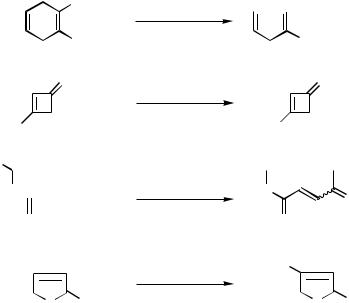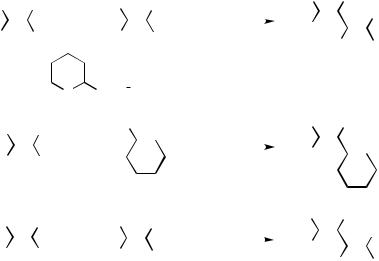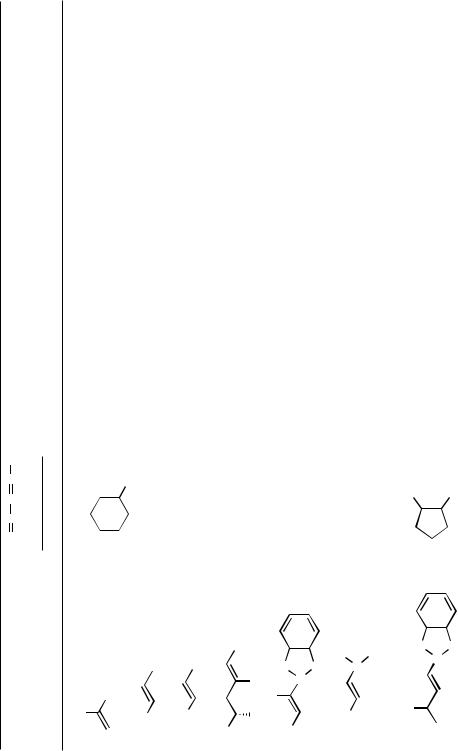

Pd
RM + XC C C
C C O
O
III.2.15 Palladium-Catalyzed
Conjugate Substitution
EI-ICHI NEGISHI and YVES DUMOND
A. INTRODUCTION
In Sects. III.2.12 – III.2.14, various Pd-catalyzed cross-coupling reactions involvingand -heterosubstituted organometals and organic electrophiles are discussed. Many of these reactions have provided attractive routes to various proximally hetero-substituted organic compounds of synthetic significance. It is also noteworthy that proximal heteroatoms tend to exert strong influences on the course of Pd-catalyzed cross-coupling. Consequently, they often demand special attention. On the other hand, remote heterofunctional groups may be expected to act largely as “innocent” bystanders not requiring special consideration. Furthermore, the number of possible structural types of heterosubstituted organometals and organic electrophiles exponentially increases as the heteroatoms move away from the cross-coupling reaction centers. For these reasons, no systematic discussions of those containing heteroatoms in the and more remote positions are intended. Nonetheless, it is worthwhile to discuss the Pd-catalyzed -substitution reactions of , -unsaturated carbonyl compounds represented by Eqs. 1 – 3 shown in Scheme 1, which may be collectively termed as conjugate substitution a` la conjugate addition. The reaction shown in Eq. 1 represents examples of the Heck reaction, which is discussed in Part IV, while those shown in Eqs. 2 and 3 represent various cases of Pdcatalyzed cross-coupling involving -oxo-alkenyl electrophiles and -oxo-alkenylmetals. In this section, these latter two reactions are discussed.
As in many other cases, the Heck reaction shown in Eq. 1 and the cross-coupling reactions shown in Eqs. 2 and 3 achieve similar synthetic transformations. Since the crosscoupling version is somewhat more involved than the corresponding Heck reaction, it must offer some clearcut advantages over the latter to justify more elaborate synthetic operations. In this connection, the following distinct difference between the Heck reaction shown in Eq. 1 and the cross-coupling shown in Eq. 2 should clearly be noticed. In the former, a Pd(0) complex is to undergo oxidative addition with RX to produce RPd(II)X, which then is to react with an , -unsaturated carbonyl derivative. The latter process involving the interaction of an intrinsically electrophilic RPd(II)X with the electron-deficient C"C bond of the , -unsaturated carbonyl compound is less favorable than that with normal and elec- tron-rich alkenes. On the other hand, electron-deficient -halo- , -unsaturated carbonyl compounds generally undergo oxidative addition with Pd(0) complexes with ease even in
Handbook of Organopalladium Chemistry for Organic Synthesis, Edited by Ei-ichi Negishi ISBN 0-471-31506-0 © 2002 John Wiley & Sons, Inc.
767

768 III Pd-CATALYZED CROSS-COUPLING |
|
|
|
|
|
|
|
|
|
|||||||||||||
|
|
|
|
|
|
|
|
|
O |
|
|
|
|
|
O |
|
||||||
|
|
|
|
|
|
|
|
|
|
|
|
|
|
|
||||||||
|
|
|
|
|
|
|
|
|
|
|
|
cat. PdLn |
|
|
|
|
|
|
|
|
|
(1) |
|
|
|
|
|
|
|
|
|
|
|
|
|
|
|
|
|
|
|
||||
|
RX |
|
|
|
HC |
|
C |
C |
RC |
|
C |
C |
||||||||||
|
|
|
|
|
|
|
|
|
|
|
|
Heck reaction |
|
|
|
|
|
|
|
|
|
|
|
|
|
|
|
|
|
|
|
|
|
|
|
|
|
|
|
||||||
|
|
|
|
|
|
|
|
|
O |
|
|
|
|
|
O |
|
||||||
|
|
|
|
|
|
|
|
|
|
|
|
|
|
|
||||||||
|
|
|
|
|
|
|
|
|
|
|
|
cat. PdLn |
|
|
|
|
|
|
|
|
|
|
|
|
|
|
|
|
|
|
|
|
|
|
|
|
|
|
|
|
|
|
|
||
|
RX |
|
|
|
XC |
|
C |
C |
RC |
|
|
C |
C |
(2) |
||||||||
|
|
|
|
|
cross-coupling |
|
|
|||||||||||||||
|
|
|
|
|
|
|
|
|
|
|
|
|
|
|
|
|
|
|
|
|
||
|
|
|
|
|
|
|
|
|
O |
|
|
|
|
|
O |
|
||||||
|
|
|
|
|
|
|
|
|
|
|
|
|
|
|
||||||||
|
|
|
|
|
|
|
|
|
|
|
|
cat. PdLn |
|
|
|
|
|
|
|
|
|
(3) |
|
|
|
|
|
|
|
|
|
|
|
|
|
|
|
|
|
|
|
|
|||
|
RX |
|
|
|
MC |
|
C |
C |
RC |
|
C |
C |
||||||||||
|
|
|
|
|
cross-coupling |
|
||||||||||||||||
|
|
|
|
|
|
|
|
|
|
|
|
|
|
|
|
|
|
|
|
|
||
|
|
|
|
|
|
|
|
|
|
|
|
|
|
|
|
|
|
|
|
|
|
|
Scheme 1
cases where the halogen atom is Br or Cl. -Oxy- , -unsaturated carbonyl compounds containing TfO, MsO, and other oxy groups are also attractive, since they are not only sufficiently reactive but also readily accessible via -oxo-substituted carbonyl compounds. The reaction of the resultant -oxo-alkenylpalladium derivatives with a variety of organometals is also generally very facile. Consequently, the overall process represented by Eq. 2 is generally favorable, making it a synthetically useful transformation. The analysis above also suggests the reaction shown in Eq. 3 might, at least in some cases, be comparatively less favorable than that shown in Eq. 2.
Another significant difference between the two reactions shown in Eqs. 1 and 2 lies in the difference in accessibility of RPdX to be generated in situ via oxidative addition in Eq. 1 on the one hand and RM in Eq. 2 on the other. In the cases of alkenyl and aryl derivatives, the required reagents in the two reactions are comparably accessible. On the other hand, organopalladium intermediates containing alkynyl and alkyl groups are more readily available in Eq. 2 than in Eq. 1, since generation of alkynylpalladium derivatives via oxidative addition of 1-haloalkynes is more involved than that via transmetallation with alkynylmetals and since alkyl halides are generally very sluggish to undergo oxidative addition with Pd. Yet another difference between Eq. 1 and Eq. 2 lies in the extents of selectivity and specificity in terms of regioand stereochemistry. As discussed in Part IV, the Heck reaction proceeding via addition and elimination is prone to regioand/or stereoisomerization, which can often be avoided or minimized by resorting to Pdcatalyzed cross-coupling.
The reaction of alkenylalanes with methyl (E )- -bromomethacrylate catalyzed by Cl2Pd(PPh3)2 2 DIBAH (Scheme 2) appears to represent the first example of conjugate substitution, which was reported in 1976.[1] Since then, essentially all possible classes of
|
|
|
|
|
|
|
|
|
Br |
|
Me |
|
|
|
|
|
|
|
|
|
|
|
|
|
|
|
C |
|
C |
|
|
|
|
|
|
|
|
|
|
|
|
|
|
|
|
|
|
|
|
|
|||
|
|
|
|
|
|
|
|
|
|
|
|
|
|
|
|||
|
|
|
|
|
|
|
|
|
H |
|
COOMe |
|
|
|
|
|
|
|
|
|
DIBAH |
R |
|
|
H |
Cl2Pd(PPh3)2 + 2 DIBAH |
R |
|
H |
|
|
||||
RC |
|
CH |
|
C |
|
C |
C |
|
C |
|
Me |
||||||
|
|
|
|
|
|
|
|
|
|
|
|||||||
|
|
|
|
|
|
|
|
|
|
||||||||
|
|
|
|
|
H |
|
|
AlBu2 |
|
|
|
|
H |
|
C |
|
C |
|
|
|
|
|
|
|
|
|
|
|
|
|
|||||
|
|
|
|
|
|
|
|
|
|
|
|
|
|||||
H COOMe
75%, > 97% E,E
Scheme 2

III.2.15 Pd-CATALYZED CONJUGATE SUBSTITUTION |
769 |
organometals have been employed in this reaction mainly using Zn, Al, Zr (Negishi protocol), Sn (Stille protocol), and B (Suzuki protocol). In addition, alkynes have also been used by following the Sonogashira protocol. As in many other cases, the relative merits and demerits among various protocols are not very clear, since critical comparative data are largely lacking.
Specific examples of Eq. 2 are presented in Sect. B.
Although the charge-affinity inverted version of Eq. 2, that is, Eq. 3, might be intrinsically less favorable than Eq. 2, many such reactions can still proceed satisfactorily. In the great majority of cases, -stannyl- , -unsaturated carbonyl compounds have been used as the organometallic reagents, although some examples of -zinco- , -unsaturated carbonyl compounds have also been reported recently. In cases where both Eq. 2 and Eq. 3 are satisfactory, the comparative accessibility of the required reagents can be the critical factor, which generally favors the protocol represented by Eq. 2. The opposite, however, is true in some cases. For example, acylmetals containing main group metals are not as readily accessible as acyl halides. This clearly favors Eq. 3, as exemplified by the results shown in Scheme 3.
COOMe
SnBu3
O
+ RCOCl
Bu3Sn
R  (CH2)nCH2COCl
(CH2)nCH2COCl
O
 SnBu3
SnBu3
O
n = 3, 4, 5, 7, 9, 13
Bu3Sn
+ RCOCl
O  O
O
PhCOCl
Cl2Pd(PPh3)2
CHCl3
[2]
ClPdBn(PPh3)2
MeCN
[3]
ClPdBn(PPh3)2 CO (3 atm) Toluene, DMF
[4]
ClPdBn(PPh3)2
CHCl3
[5]
Scheme 3

 COOMe
COOMe
COPh
70%
O
RCO 53−81%
R (CH2)n
(CH2)n
O
O
O 15−70%
PhCO
87% O  O
O
Additional specific examples of Eq. 3 are presented in Sect. C.
A number of aryl halides and arylmetals, especially those containing heteroatoms, are formally represented as , -unsaturated carbonyl derivatives. Although their crosscoupling reactions may be formally classified as conjugate substitution processes, various requirements for these cases may be significantly different than in those cases discussed in Sects. B and C because of their aromatic nature. For this reason, specific examples of these reactions together with those of the reactions of quinone derivatives are discussed separately in Sect. D.

770 |
III Pd-CATALYZED CROSS-COUPLING |
Finally, there are many variations of conjugate substitution including those of , - unsaturated nitriles, acetals, sulfones, and sulfoxides. These miscellaneous variants are discussed in Sect. E.
B. CONJUGATE SUBSTITUTION OF -HALO- , -UNSATURATED
CARBONYL AND RELATED DERIVATIVES
B.i. Conjugate Substitution with Alkenylmetals
As shown in Scheme 2, Pd-catalyzed conjugate substitution with alkenylmetals was achieved first with alkenylalanes generated in situ by hydroalumination of alkynes.[1] This synthetically attractive hydrometallation – cross-coupling tandem process was soon extended so as to include hydrozirconation,[6] carboalumination,[7] and so on. It was also found that, in more demanding cases, addition of Zn salts (e.g., ZnCl2 and ZnBr2) significantly accelerates Pd-catalyzed cross-coupling[8] (Scheme 4). In most cases, these reactions are essentially 100% stereospecific. In some demanding cases, however, extensive stereochemical isomerization, especially Z-to-E isomerization, has been observed.[9]
R |
H |
Br |
Me |
A |
R |
H |
||||||||||||||||
|
|
|
|
|
Me |
|||||||||||||||||
|
|
|
+ |
|
|
|
|
|
|
|
|
|
|
|
|
|
||||||
|
|
|
|
|
|
|
|
|
|
|
|
H |
|
|
||||||||
|
|
|
|
|
|
|
|
|
|
|
|
|
|
|
|
|
||||||
|
|
|
|
|
|
|
|
|
|
|
[6] |
|
|
|
|
|
||||||
H |
|
ZrCp2Cl |
H |
COOMe |
|
|
|
|
|
|||||||||||||
|
|
|
|
|
|
|||||||||||||||||
|
|
|
|
|
|
|
|
|
||||||||||||||
|
|
|
H |
|
|
COOMe |
||||||||||||||||
|
|
|
|
|
|
|
|
|
|
|
|
|
|
|
|
|
|
|||||
R = n-Bu, |
|
|
|
|
|
|
|
|
|
70−75% |
||||||||||||
|
|
|
|
|
|
|
|
|
|
|
|
|
|
|
|
|
||||||
|
|
|
|
|
O |
OCH2 |
|
|
|
|
|
|
|
|
|
|
|
|
|
|
||
Bu |
|
|
H |
Br |
|
|
|
|
|
A |
Bu |
H |
||||||||||
|
|
|
|
|
|
|
|
|
|
|
|
|
|
|
|
|
|
|||||
|
|
|
|
|
+ |
|
|
|
|
|
|
|
|
|
|
|
|
|
|
|
|
|
|
|
|
|
|
|
|
|
|
|
|
|
|
|
H |
|
|
|
|
|
|||
|
|
|
|
|
|
|
|
|
|
|
|
|
|
|
|
|
|
|
||||
|
|
|
|
|
|
|
|
|
|
|
O |
[6] |
|
|
|
|
|
|||||
H |
|
|
ZrCp2Cl |
|
|
|
|
|
|
|
|
|
|
O |
||||||||
|
|
|
|
|
|
|
|
|
|
|
|
|||||||||||
|
|
|
|
|
|
|
|
|
|
|
|
|||||||||||
|
|
|
|
|
|
|
|
|
|
|
|
|
|
|
|
|
|
|||||
|
|
|
|
|
|
|
|
|
|
|
|
|
|
|
60% |
|
|
|
|
|
||
|
|
|
|
|
|
|
|
|
|
|
|
|
|
|
|
|
|
|
|
|||
|
|
|
|
|
|
|
|
|
|
|
|
|
|
|
|
|
|
|
|
|
||
Et |
|
|
Et |
Br |
Me |
|
Et |
Et |
||||||||||||||
|
|
B, ZnCl2 |
|
|
|
|
|
Me |
||||||||||||||
|
|
|
|
+ |
|
|
|
|
|
|
|
|
|
|
|
|
|
|||||
|
|
|
|
|
|
|
|
|
|
|
|
H |
|
|
||||||||
|
|
|
|
|
|
|
|
|
|
|
|
|
|
|
|
|
|
|||||
|
|
|
|
|
|
|
|
|
|
|
|
[8] |
|
|
|
|
|
|||||
H |
|
|
M |
H |
COOMe |
|
|
|
|
|
||||||||||||
|
|
|
|
|
|
|
||||||||||||||||
|
|
|
|
|
|
|
|
|
|
|||||||||||||
|
|
|
|
H |
|
|
COOMe |
|||||||||||||||
|
|
|
|
|
|
|
|
|
|
|
|
|
|
|
|
|
|
|||||
A = Cl2Pd(PPh3)2 + 2 DIBAH, B = Pd(PPh3)4 |
|
65−85%, > 97% E,E |
||||||||||||||||||||
|
|
|
|
|
|
|
|
|
|
|
|
Scheme 4 |
|
|
|
|
|
|
|
|
||
Subsequent studies have established that conjugate substitution of -halo- , -unsa- turated carbonyl compounds with alkenylmetals is a generally favorable reaction, which can be achieved by using B, Sn, and Zn in addition to Al and Zr mentioned above. Although -iodo derivatives appear to be the most reactive, -bromo, -sulfonyloxy (e.g., TfO, MsO, FSO3), and even -chloro derivatives in some cases are satisfactory. Some representative examples of conjugate substitution with alkenylmetals are presented in Table 1.

TABLE 1. Conjugate Substitution with Alkenylmetals
O C C C X
β  R
R
α  R
R
 Y
Y
Yield (%) Reference
Conditions
E or Z
X
β R
α R
Y
Alkenylmetal
[10] |
[8] |
94 |
65 |
Pd(PPh THF,25°C |
Pd(PPh |
2 |
equiv.1ZnCl |
||
4 |
4 |
|
) |
) |
|
3 |
3 |
|
E
|
|
|
|
Br |
Br |
|
|
|
|
|
H |
O |
|
|
|
|
Me |
|
|
||||
|
|
||||
|
|||||
|
|
|
|
|
OMe |
|
|
2 |
|
TMEDA |
Al(Bu-i) |
3 |
ZnBr- |
|
CF |
|
n-Bu |
|
|
[8]
85
|
2 |
3 |
ZnCl |
4 |
|
) |
1equiv. |
Pd(PPh |
E
OMe Me H Br
Cl
2
ZrCp
n-Bu
|
[9] |
|
|
[11] |
|
|
40 |
|
|
88 |
EtOH75%reflux |
Pd(PPh |
ZnClequiv.1 |
Pd(OAc) |
NaCO |
||
|
|
3 |
|
|
|
|
2 |
PPh |
|
|
|
4 |
|
/2 |
|
|
|
) |
|
2 |
|
|
|
3 |
|
|
|
3 |
|
|
|
|
|
|
|
Z isomerizedintoE) |
|
|
E |
|
|
|
(Z |
|
|
|
|
|
Br |
|
|
Br |
|
|
H |
|
|
H |
|
|
H |
|
|
H |
|
|
OMe |
|
|
OEt |
|
|
2 |
|
|
|
|
|
AlMe |
|
|
|
|
|
H) |
|
|
|
|
|
Me |
Alkyl(or O |
B |
O |
|
Me |
TBSO |
Alkyl |
|
|
|
[12] |
|
|
[13] |
(Continued) |
−80 |
|
|
96 |
|
70 |
|
|
|
|
/TPPS |
2 |
|
dioxane |
|
|
NH |
) 85C,° |
|
|
2 |
Pri |
|
||
Pd(OAc) CH |
Et |
4 |
K |
|
Pd(PPh |
|
|||
CN |
or N |
3 |
4 |
|
3 |
PO |
|
||
|
|
|
, |
|
|
3 |
|
3 |
|
Z
|
I |
|
Et |
|
|
|
|
|
|
|
|
|
|
||
|
|
|
2 |
|
|
|
OTf |
|
H |
|
CO |
|
|
||
|
H |
|
|
|
|
|
|
|
|
|
|
|
|
|
|
|
OEt |
|
|
|
|
|
|
|
|
3 |
|
|
|
|
|
|
|
) |
|
|
|
|
|
|
|
2 |
|
|
|
|
|
OW |
|
OW W=Hor(CH |
O |
|
|
O |
|
B |
B |
||||||
Bu |
|
|
OTBS |
|
|
|
|
|
|
|
|
11 |
|
||
|
|
|
|
|
H |
|
|
|
|
|
|
|
5 |
|
|
|
|
|
|
|
C |
|
|
771

TABLE 1. (Continued )
O C C C X
β  R
R
α  R
R
 Y
Y
Reference
Yield (%)
Conditions
E or Z
X
β R
α R
Y
Alkenylmetal
[12] |
[14] |
[13] |
[14] |
[14] |
[15] |
[16] |
95 |
|
|
84−98 |
|
|
97 |
|
|
98 |
|
85 |
|
99 |
|
94 |
|
|
|
|
|
|
|
|
|
|
|
|
|
|
°C |
|
/TPPS |
2 |
2 |
3 |
|
|
3 |
|
|
3 |
|
3 |
|
3 |
80 |
3 |
|
|
|
|
|
|
NMP,, |
AsPh/2 |
||||||||
|
|
NH |
|
|
|
|
|
|
|
|
|
|
2 |
|
Pd 35NMP−40C° |
Pd(OAc) |
O |
) |
refluxMeOH |
NaOAc |
) |
refluxMeOH |
NaOAc |
) |
NaOAc |
) |
NaOAc |
CN) |
furyl)-P(2 |
||
CH |
Et |
PdCl |
PdCl |
PdCl refluxMeOH |
PdCl refluxMeOH |
PdCl |
|||||||||
|
|
|
2 |
|
|
2 |
|
|
2 |
|
2 |
|
|
|
|
2 |
H-CN |
Pr |
(PPh |
|
|
(PPh |
|
|
(PPh |
|
(PPh |
|
(CH |
3 |
3 |
|
3 |
orNi |
2 |
|
|
2 |
|
|
2 |
|
2 |
|
2 |
|
(dba) |
|
|
3 |
|
|
|
|
|
|
|
|
|
|
|
|
2 |
E |
Z |
|
|
|
|
I O |
|
|
|
Cl O Me |
|
Br O |
Me |
|
Br |
CHO |
|
Cl |
OMeallylH Br |
OEtMe Et OTf |
|
O |
|
|
|
|
|
|
|
|
|
|
|||||||||
|
|
|
|
|
|
|
|
|
|
|
|
|
|
||||||
|
|
|
|
|
|
|
|
|
|
||||||||||
|
|
|
|
|
|
|
|
|
|
|
|
|
|
|
|
||||
|
|
|
|
|
|
|
|
|
|
|
|
|
|
3 |
|||||
OH |
OH |
|
|
|
|
|
|
|
|
|
|
|
|
|
|
|
SnBu |
||
|
|
|
|
|
|
|
|
|
|
|
|
3 |
|
|
|
|
|
||
|
|
|
|
|
|
|
|
|
|
|
|
|
|
|
|
|
|||
|
B |
|
|
|
|
|
|
|
|
|
|
|
|
|
|
|
|
|
|
|
O B O |
O B O |
O B O |
O B O |
SnBu |
|
|
|
|
|
|||||||||
|
|
|
|||||||||||||||||
|
|
|
|
|
|
|
|||||||||||||
|
|
2 |
|
|
|
|
|
|
|
|
|
|
|
|
|
|
|
|
|
-Bu |
|
R |
|
|
|
|
|
|
|
|
|
|
|
|
|
|
|
||
|
|
|
|
|
|
|
|
|
|
|
|
|
|
|
|
||||
|
|
|
|
|
|
|
|
|
|
|
|
|
|
|
|
|
|
||
|
R |
Bu-n |
Bu-n |
Bu-t |
|
|
|
Si |
|||||||||||
n |
|
|
|
|
Me |
||||||||||||||
|
|
1 |
|
|
|
|
|
|
|
|
|
|
|
3 |
|||||
|
|
|
|
|
|
|
|
|
|
|
|
|
|
|
|
|
|
|
|
772

[17] |
[18] |
95 |
73 |
2 |
|
|
) |
|
|
3 |
Pd(PPh THF,reflux |
LiBr |
BnPdCl(PPh HMPA,55C° |
||
|
4 |
|
|
) |
|
|
3 |
|
C |
|
I O |
|
Me |
OMs |
|
11 |
|
|
|
|
|
|
H |
|
|
|
|
|
|
5 |
|
|
|
|
|
|
O |
|
|
|
|
|
O |
|
|
|
|
|
||
|
|
|
|
|
||
|
|
|
|
|
|
|
[19]
84
3 furyl)-P(2
/2 C ° 2 Pd(dba) 25THF,
I |
Et |
|
2 |
|
CO |
[16]
91
3 AsPh/2
3 (dba) 2 Pd
NMP 35−40 °C
F 2 OSO
[20]
95
ligandless“ ” |
2 |
|
r.t. , |
|
2 |
|
Cl |
3 |
orCH |
(dba) |
|
Pd |
NMP |
2 |
|
|
OTf |
|
Bz |
|
2 |
S |
CO |
|
N |
|
O |
[21]
58
3 |
|
,AsPh |
|
3 |
|
(dba) |
DMF |
Pd |
|
2 |
|
 O O
O O



I
3 SnBu
3 SnBu
3 SnMe
OH
17 H 8 C
3 SnBu
Si
3
Me
3 SnBu
3  SnBu OMOM
SnBu OMOM

773

774 |
III Pd-CATALYZED CROSS-COUPLING |
B.ii. Conjugate Substitution with Arylmetals
As might be expected from the foregoing discussions, Pd-catalyzed conjugate substitution of -halo- , -unsaturated carbonyl derivatives with arylmetals is also generally favorable. As metal countercations, Zn, B, and Sn, but not Al or Zr, have been employed. Under specifically optimized conditions, Zn, B, and Sn seem to provide the desired products in comparable yields. The ready in situ generation is a distinct advantage associated with Zn, while higher chemoselectivity and reagent storability are some of the advantages associated with B and Sn. Some representative examples are summarized in
Table 2.
B.iii. Conjugate Substitution with Alkynylmetals
The Pd-catalyzed reaction of 1-hexynylzinc bromide with methyl (E)- -bromomethacry- late[30] shown in Scheme 5 appears to be the prototypical example of this class of reactions.
|
|
Br |
|
Me |
Pd(PPh3)4 |
|
|
|
|
|
|
|
THF |
n-BuC |
|
C |
Me |
||
n-BuC |
|
CZnBr + |
|
|
|
||||
|
|
|
|
||||||
|
|
|
|
|
|
|
|
[30]
H COOMe
H COOMe
87%, > 97% E
Scheme 5
In addition to Zn, B, and Sn—three metal countercations that were found to be highly satisfactory for alkynylation[31]—the Sonogashira alkynylation protocol (Sect. III.2.8.1) has also proved to be generally applicable to this case. Some representative examples of Pd-catalyzed conjugate substitution with alkynylmetals and terminal alkynes are summarized in Table 3.
B.iv. Conjugate Substitution with Alkylmetals
B.iv.a. Synthesis of 1,5-Dienes Via Conjugate Substitution with Homoallyland Homopropargylmetals. Pd-catalyzed conjugate substitution with alkylmetals was first investigated with the goal of developing a convenient and selective route to 1,5-dienes of terpenoid origin.[36],[37] The reaction of homoallylzincs with -halo- , -unsaturated carbonyl compounds in the presence of a Pd catalyst or Ni catalyst in some cases has been shown to be generally satisfactory.[37] Although not specifically demonstrated, conjugate substitution with homopropargylmetals, for example, homopropargylzincs, is also expected to proceed similarly.[36] Some representative examples, especially those applied to the synthesis of natural products, are summarized in Scheme 6.
For a more general discussion of Pd-catalyzed cross-coupling with homoallylic and homopropargylic organometals, readers are referred to Sect. III.2.11.2.
B.iv.b. Conjugate Substitution with Allyl-, Propargyl-, and Benzylmetals. As discussed in Sects. III.2.9 and III.2.10, Pd-catalyzed cross-coupling involving allylmetals of relatively electropositive metals, such as Zn and Mg, has not been generally satisfactory. Propargylmetals most probably resemble allylmetals in this respect, although the same difficulty is not shared by benzylmetals. For Pd-catalyzed allylation with allylmetals,

TABLE 2. Conjugate Substitution with Arylmetals
X |
|
|||
C |
β |
|||
R |
||||
|
|
|
α |
|
C |
||||
R |
||||
|
|
Y |
||
C |
||||
|
|
|
||
O |
|
|||
Yield (%) Reference
Conditions
E or Z
X
β R
α R
Y
ArM
[22]
83
2 ) 3 (PPh 2 PdCl
Z
OH H Me I
PhZnBr
[23]
89
3 |
|
10%Pd/C/4AsPh |
THF,r.t. |
Z
OEt Br H Br
ArZnCl
[23]
96
3 AsPh/4
Pd/C10% r.t.THF,
E
OEt Br H Br
ZnCl
[23] |
[24] |
|
[24] |
|
[25] |
(Continued) |
69 |
77−85 |
|
52−79 |
|
86 |
|
|
|
|
|
|
3 |
|
3 |
|
|
|
|
AsPh |
O |
AsPh |
|
|
|
|
Cl |
Ag |
|
|
|
|
|
/4 |
2 |
|
|
|
|
|
2 |
|
Pd/C10%/4 THF,r.t. |
Pd(PPh |
THF,20 °C |
Pd(PPh |
THF,20 °C |
2 |
THF,20 °C, |
Pd(PhCN) |
||||||
|
4 |
4 |
|
|
||
|
) |
|
) |
|
|
|
|
3 |
3 |
|
|
||
E |
Z |
|
E |
|
Z |
|
Br |
Br |
|
Br |
|
OTf |
homoallyl |
BrH |
BrH |
|
BrH |
|
HR |
|
|
|
|
|
|
β |
|
OEt |
OEt |
|
OEt |
|
OEt |
= |
|
|
R |
||||
|
|
|
|
|
|
β |
ZnCl |
|
|
|
|
|
|
MeO |
ArZnX-FG |
|
ArZnXFG− |
|
PhB(OH) |
|
|
|
|
|
|
2 |
|
775

X |
|
|||
C |
β |
|||
R |
||||
|
|
|
α |
|
C |
||||
R |
||||
|
|
Y |
||
C |
||||
|
|
|
||
O |
|
|||
TABLE 2. (Continued )
Yield (%) Reference
Conditions
E or Z
X
β R
α R
Y
ArM
[26] |
[27] |
[28] |
[29] |
70−95 |
85−90 |
80 |
70−87 |
|
3 |
|
|
2 |
|
|
/AsPh |
|
|
|
|
Pd(dba) KOH,aq.THF |
|
|
|
/CuI |
|
2 |
) |
|
) |
°C |
|
(PhCN) |
|
3 |
|||
PdCl r.t.NMP, |
2 |
r.t.THF, |
BnPdCl(PPh |
Ch |
|
Pd(PPh |
|||||
2 |
2 |
Cl |
|
|
70 CN, |
3 |
|
|
|||
|
|
2 |
|
|
|
|
|
|
|
|
3 |
Z |
Z |
HH |
OTf |
O |
CO |
HBrOEtBr |
BrPhMe I unreacted)(Br |
X |
=XMe,OPr-i |
Cl |
|
|
|
PNB |
|
|
|
|
|
|
|
|
2 |
|
|
|
|
|
|
|
|
|
|
|
|
|
|
|
|
|
|
|
|
|
|
|
RO |
Me |
|
|
|
|
O |
|
O |
|
|
|
|
|
2 |
PhSnBu |
PhSnMe |
PhSnMe |
ArB(OH) |
|||
|
3 |
3 |
3 |
776
